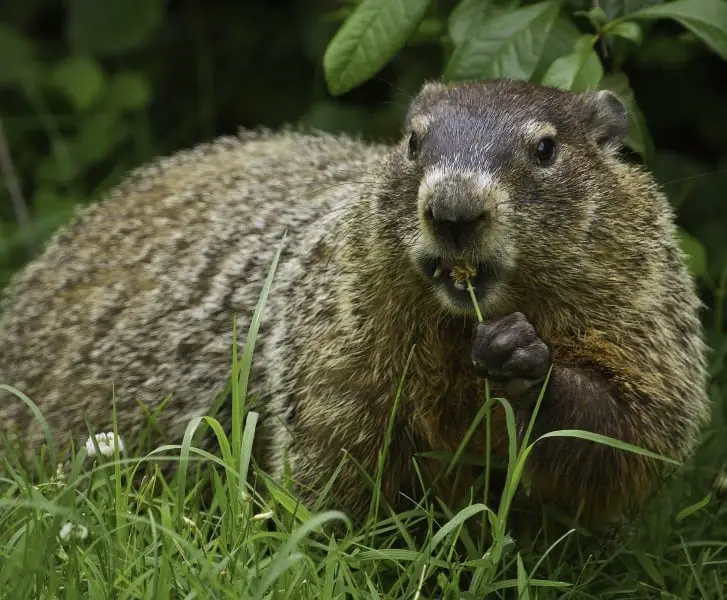Ever wondered what do groundhogs eat? Well, in this article we’re going to go over the types of foods that groundhogs look to feed on.
But first, in a pinch here’s the takeaway answer, then we’ll explore this in more detail…
What Do Groundhogs Eat? Groundhogs are omnivores but eat mostly plants, vegetables, fruits, and other greens like grasses, clovers, alfalfa, dandelions, weed, lettuce, squash, peas, broccoli, beans, carrots, soybeans, corn, apples, red and black raspberries, and cherries. They occasionally feed on small insects and birds.
Groundhogs, or woodchucks, are generally accepted as herbivores and so it’s assumed that a ground hog’s diet consists of plants only. Surprisingly though, groundhogs may not be completely herbivores… and to give you a detailed understanding of a groundhog’s diet, the following sections will be helpful.
Read on, or watch the video further down from the Ranger Planet Youtube Channel.
Plants, vegetables, and fruits in a groundhog’s diet
Plants make up the majority of a groundhog’s diet. Or perhaps we should say groundhogs feast mostly on a plant-based diet. Groundhogs enjoy a variety of grasses,
- Maple leaves
- Clovers
- Alfalfa
- Dandelions
- Weeds
- Other similar plants

Groundhogs also enjoy agricultural or cultivated crops, such as:-
- Lettuce
- Squash
- Peas
- Broccoli
- Beans
- Carrots
- Soybeans
- Corn
Groundhogs even eat some picky fruits, such as:-
- Apples
- Red raspberries
- Black raspberries
- Cherries
- Hackberries
- Mulberries
- Other similar berries
Groundhogs eating cultivated crops bring huge losses to farmers. This is one of the reasons why farmers try to get rid of groundhogs using pest control methods.
Interestingly, although a groundhog may look small, a fully grown or mature groundhog can eat more than a pound of plants (which includes crops) per day.
When comparing the amount of food a groundhog can eat in a day, it’s actually a greater amount than the average-sized groundhog. This shows how heavy a groundhogs plant-based diet is and how a number of them can impact a sizeable area in a short space of time.
Animals in a groundhog’s diet
While groundhogs are considered predominantly herbivores, there are some dietary patterns of a groundhog that prevent us from calling them complete herbivores.
This means that it’s not uncommon to find groundhog’s eating small animals, such as:-
- Juvenile birds
- Birds eggs
- Snails
- Grasshoppers
- Crickets
- Grubs
- Bugs
- Other similar small animals
Groundhogs may also eat baby birds that they come across by chance. Groundhogs also eat eggs and even large insects like June bugs and grasshoppers.
However, plants will remain a major part of a groundhog’s diet that as such groundhogs are comfortable existing for long periods without feeding on anything other than plants and greens.
A groundhog’s diet during the seasons
A groundhog’s diet changes through the seasons depending on the availability of food.
Spring and Summer
During summer and spring, groundhogs will forage at dusk for greens and plants like hackberry, mulberry, blackberry, and maple leaves.
During these seasons they’ll also occasionally feed on grasshoppers, grubs, and snails, but these will make up a very small percentage of the diet.
Fall
In early fall, when greens fall, groundhogs start to feed on tree bark, small branches/twigs, and any available small insects. This is where groundhogs will switch mostly to animals in their diet as plants and greens dry out and animals provide a greater amount of protein and fat for the winter months.
In fall, groundhogs will also load up foods in their dens and burrows, as preparation for the coming winter.
Winter
During winter groundhogs will hibernate – waking up occasionally to feed on the food reserves in their winter dens and burrows.
The feeding style of groundhogs is heavily in favor of that of a herbivore. Their feeding period is around two hours at a time during summer, spring, and fall, they spend less time eating during winter as a way of saving up energy.
During the seasons of spring, summer, and fall, groundhogs consume a large portion of their diet during the morning and evening. Whereas in winter they only eat small amounts of food.
Learning resources
We’ve found the ideal resources to continue your learning at home and at school on amazon. Help support our efforts for wildlife causes and keep this site working for nature. Amazon also donates to wild-life related charities!
Groundhog Secrets: Everything You Always Wanted to Know about Woodchucks
Related articles
Video resources
To finish up…
We hope this has been useful in understanding more about groundhog feeding habits and the types of food they will eat through the year, be sure to check out other resources on the site for more education and fun with wildlife!
This content has been checked and verified by a qualified veterinary practitioner. The article has been reviewed by our editorial board and has been approved for publication in accordance with our editorial policy.
